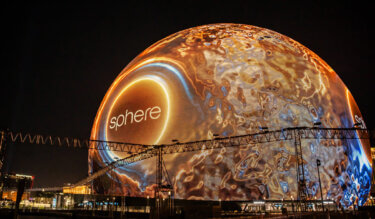Our 2015 prediction for the future of stadiums could be summed up in one word: extension. We envisioned sports stadiums and arenas evolving far beyond the traditional boundaries of the playing field and stands, both through technological advances and changes in the way we think about physical footprints of sports complexes. So, how did we measure up?
“Video walls will be built directly into stadium architecture.”
While we knew the incorporation of video into stadium architecture would evolve quickly in the decade following 2015, we didn’t anticipate it to happen on such an iconic scale as The Sphere—where the video wall has effectively become the stadium. Now unmistakable on the Las Vegas Skyline and one of the most recognizable venues in the world, The Sphere utilizes video walls in ways never seen before its grand opening in 2023.

The multiuse venue, which has played host to a variety of sporting events, including UFC 306 and the NHL 2024 Entry Draft, boasts 580,000 square feet of LED displays on its exterior, and another 160,000 square feet of video display inside, wrapping over half of the 18,600-seat arena. While the exterior display helps generate hype for upcoming events and provides unique advertising opportunities, the interior video walls deliver a fully immersive experience for attendees—one that is unmatched anywhere else.
At UFC 306, which occurred over Mexican Independence Day weekend and featured several Mexican fighters, a series of short films celebrating Mexico’s storied history in combat sports was showcased on the interior screen. The films were created specifically for The Sphere’s display, offering a one-of-a-kind experience for attendees.
Future Still Pending Department – predictions that have not yet arrived
“On-field holographic replays in the next 5-10 years”
Were we wrong—or just early? While we haven’t yet seen holographic players take the field for replays, extended reality technology is changing the way fans interact in physical space with their favorite sports and teams.
At the aforementioned UFC 306, attendees were greeted by a hologram of UFC President and CEO Dana White upon entry. Created by Proto, Inc., the hologram was part of their broader portfolio of sports activations, which most recently includes a partnership with the Chicago Bulls for “Derrick Rose Night”.
A year earlier, the Dallas Cowboys unveiled a holographic version of team owner Jerry Jones that enabled fans at AT&T Stadium to interact with him.
On the interactive-replay front, Intel’s True View camera arrays, installed at a variety of sports venues, capture volumetric video data to deliver immersive 360-degree replays and player perspectives that offer fans a view they don’t typically experience. Fans aren’t yet viewing these replays within the confines of the stadium, but rather on their phone screens and from the comforts of their own couches.
While we may have been too bullish on how quickly stadiums would fill real-world gridirons, diamonds and courts with holo-casts, it’s only a matter of time before holograms take the playing field.
